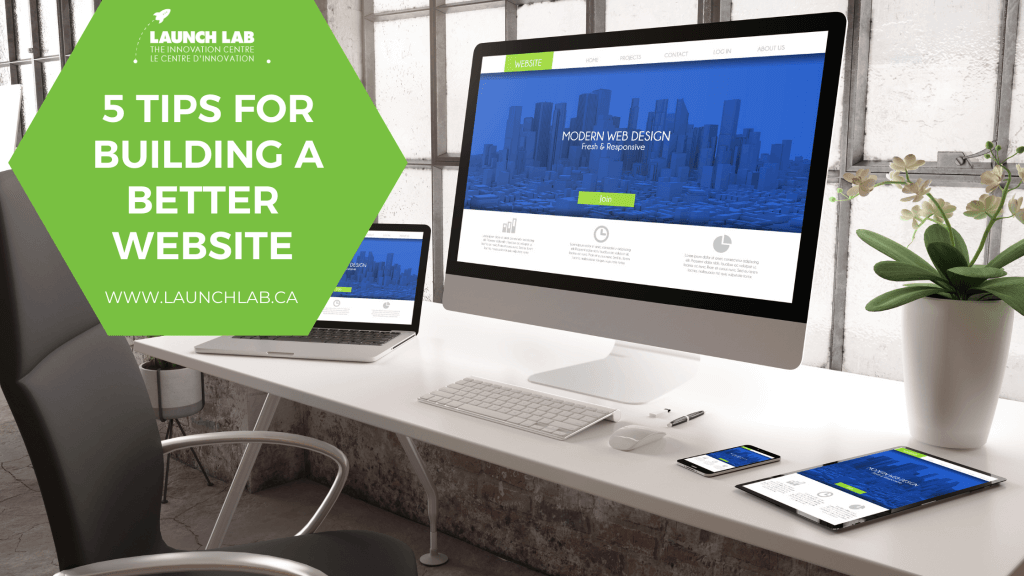Home » 5 Tips for Building a Better Website
5 Tips for Building a Better Website

5 Tips for Building a Better Website

Are you scratching your head wondering why your website isn’t accomplishing what you want it to? Do you find that your website is getting traffic, but isn’t doing its job when converting leads to sales? This blog will help you identify some key issues, and how you can turn your website into a conversion tool with our 5 tips.
Before we get started, here are a few statistics that are important to keep in mind when talking about customers and your website.
- 74% of online consumers get frustrated with websites that offer content which doesn’t directly relate to their needs and interests.
- 74% of consumers say that the ease of browsing and searching is their number one criteria for choosing one website over another.
- 87% of customers think brands need to put more effort into providing a seamless experience.
As you can see, customers care deeply about the online experience, and a website that has not been updated in years, underperforms consistently, or doesn’t reflect the brand or products well enough will fail to do its job at converting. Follow these 5 tips below to enhance your website, and increase sales.
1. Set Actionable Goals
Set actionable goals for your website, and find ways to track your success through key performance indicators. You can use Google Analytics and other third-party tools to see what pages are most popular, where each visitor came from, their demographic information, as well as what’s working and what isn’t. Pro tip: Use the Behaviour and Audience tabs in Google Analytics to see user demographics and behaviours regarding specific website pages.
2. Make Your Website Design Simple
Keep your website design simple, but also fresh and unique. Think about how the customer will navigate the website to get where they need to be. Is it easy to follow? Does your homepage answer questions including who you are, and what customers can do on the website? Will the customer know where to navigate to get what they need? When considering the design, think about who your audience is and what they need to do to make a purchase. Pro tip: Make sure you’re checking whether your website is mobile and tablet friendly to avoid bounce rates.
3. Keep Your Content Organized
Organize your website and its content to provide a positive user experience. Focus on presenting your key information first so that your audience doesn’t miss the important stuff. This is critical when converting leads into paying customers because if your customers don’t understand where to go to make the purchase, they won’t spend money. Make sure your website is well structured and presents all information in an orderly way. You want to avoid any inconsistency and think about where the readers’ eyes will go on the website. If your website is too chaotic with too much happening at once, chances are customers will simply leave. Pro tip: To organize your website correctly, try aligning text to read left or right, or try using different means of laying out content to see what works best.
4. Use Front-end and Back-end SEO Enhancement
One of the most important steps to focus on when building an improved website is SEO enhancements. Did you know that Google’s search algorithm uses more than 200 factors to rank websites? This means that if you’re not touching on at least some of these factors, your website is missing the mark when appearing on search engines. Here are some other interesting statistics regarding SEO:
- 70% of marketers see SEO as more effective than PPC (pay per click).
- 57% of marketers say on-page content development was the most effective SEO tactic.
A common misconception is that SEO enhancement pertains to only the back-end of the website when it’s actually a combination of this and on-page content that will show you the best results. This means that you must optimize content on your physical website to receive a better SEO score. This includes writing website copy that contains keywords relating to your business, enhancing your loading speed, and optimizing your text hierarchy including headings and body text. Focusing on these front-end changes will allow Google to recognize your website as an authentic source. Back-end SEO changes refer to meta information, alt text, coding, and sitemap errors. Pro tip: You can use tools like SEMRush or Ubersuggest to get information regarding your website’s current SEO ranking.
5. Use Your Online Presence to Connect to your Website
One thing to keep in mind is that your online presence, including your use of social media, makes up how customers see you and your business. Did you know that 75% of consumers expect a consistent experience wherever they engage, whether that be through the website, social media, online, or in-person? This means that consistency is key now more than ever as digital strategies move to the forefront. It’s not enough to just put out content, you have to find ways to make everything connect back to the website and to your audience. Use your social media as a tool to drive people to your website by promoting blogs, news, videos, infographics, or other media that can be posted then cross-promoted online. This is an easy way to use call to actions to drive traffic to your website, but more importantly, it creates cohesive branding throughout your online presence. Pro tip: Cater sharable content to work with each social platform. Facebook, LinkedIn, and Twitter are great when sharing links to your website. Instagram only accepts links used in your biography, not in captions.
Taking into consideration the tips above will get you to start thinking about where you are with your website, what you can do to improve, and what you’d like it to accomplish for your business. If you aren’t happy with your current website, then use these tips as a starting point to enhance it and take it to the next level.
Launch Lab
https://launchlab.ca/
We are a team of entrepreneurs helping entrepreneurs. We provide advisory services by pairing entrepreneurs with our team of experienced business owners from Kingston and most of southeastern Ontario for one-on-one mentorship and guidance. Launch Lab is a Regional Innovation Centre and member of the Ontario Business Support Network, a provincially-funded network of resources for entrepreneurs. As a RIC, our regional boundaries consist of most of southeastern Ontario (Trenton, down to Picton, over to Cornwall, and back up and around through Smiths Falls and Bancroft). We support tech-based businesses that have an innovative technology or idea, and a variety of new startups who are experiencing challenges and looking to grow. We can help you with marketing, raising investment, distribution and sales channels, business structure, intellectual property strategy, cash forecasting, and more.


